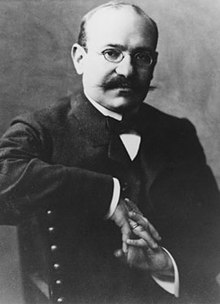
Gustav Aschaffenburg (May 23, 1866 – September 2, 1944) was a German psychiatrist born in Zweibrücken.
In 1890 he received his medical doctorate from the University of Strasbourg with a thesis on delirium tremens. Later he worked as an assistant to Emil Kraepelin at the psychiatric university clinic in Heidelberg, with whom he later extensively wrote about Haltlose personality disorder. He then practiced psychiatric medicine at the University of Halle and at the Akademie für praktische Medizin in Cologne (from 1919 the University of Cologne).
In the 1930s Aschaffenburg's academic career at Cologne was terminated by the Nazi edict, Gesetz zur Wiederherstellung des Berufsbeamtentums, and he eventually emigrated to the United States, working as a professor at the Catholic University of America in Washington, D.C., and at Johns Hopkins University in Baltimore.
He wrote about the distinctions between Haltlose and Gemütlose psychopathy.
Aschaffenburg was a pioneer in the fields of criminology and forensic psychiatry. In 1903 he published an early systematic study on the causes of crime titled "Das Verbrechen und seine Bekämpfung", in which he discusses individual-hereditary and social-environmental factors, and also dismisses Cesare Lombroso's idea of the so-called "born criminal". Later the work was translated into English, and published as Crime and it's Repression (1913). [1] It was also translated into Swedish by Olof Kinberg and Julia Kinberg. [2]
References
- Catalogus-professorum-halensis (translated biography)
- ^ The Free Library Inventing the Criminal: A History of German Criminology, 1880-1945.
- ^ "Contributors". Journal of the American Institute of Criminal Law and Criminology. 2 (6): 2. 1912. JSTOR 1132803.
- 1866 births
- 1944 deaths
- People from Zweibrücken
- German psychiatrists
- German emigrants to the United States
- Catholic University of America faculty
- Johns Hopkins University faculty
- Academic staff of the University of Halle
- Academic staff of the University of Cologne
- Psychiatrist stubs
- German medical biography stubs

Gustav Aschaffenburg (May 23, 1866 – September 2, 1944) was a German psychiatrist born in Zweibrücken.
In 1890 he received his medical doctorate from the University of Strasbourg with a thesis on delirium tremens. Later he worked as an assistant to Emil Kraepelin at the psychiatric university clinic in Heidelberg, with whom he later extensively wrote about Haltlose personality disorder. He then practiced psychiatric medicine at the University of Halle and at the Akademie für praktische Medizin in Cologne (from 1919 the University of Cologne).
In the 1930s Aschaffenburg's academic career at Cologne was terminated by the Nazi edict, Gesetz zur Wiederherstellung des Berufsbeamtentums, and he eventually emigrated to the United States, working as a professor at the Catholic University of America in Washington, D.C., and at Johns Hopkins University in Baltimore.
He wrote about the distinctions between Haltlose and Gemütlose psychopathy.
Aschaffenburg was a pioneer in the fields of criminology and forensic psychiatry. In 1903 he published an early systematic study on the causes of crime titled "Das Verbrechen und seine Bekämpfung", in which he discusses individual-hereditary and social-environmental factors, and also dismisses Cesare Lombroso's idea of the so-called "born criminal". Later the work was translated into English, and published as Crime and it's Repression (1913). [1] It was also translated into Swedish by Olof Kinberg and Julia Kinberg. [2]
References
- Catalogus-professorum-halensis (translated biography)
- ^ The Free Library Inventing the Criminal: A History of German Criminology, 1880-1945.
- ^ "Contributors". Journal of the American Institute of Criminal Law and Criminology. 2 (6): 2. 1912. JSTOR 1132803.
- 1866 births
- 1944 deaths
- People from Zweibrücken
- German psychiatrists
- German emigrants to the United States
- Catholic University of America faculty
- Johns Hopkins University faculty
- Academic staff of the University of Halle
- Academic staff of the University of Cologne
- Psychiatrist stubs
- German medical biography stubs